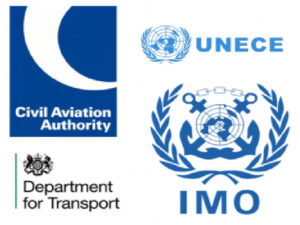Moving freight is fraught with acronyms and dangerous goods is no exception.
We have complied an A to Z list of must know terminology in the logistics industry.
Ammunition – Generic term related mainly to articles of military application consisting of all kinds of bombs, grenades, rockets, mines, projectiles and other similar devices or contrivances.
Approval – An authorisation granted by the appropriate national authority for; the transport of dangerous goods forbidden on a passenger and/or cargo aircraft where the regulations state that goods may be carried with an approval.
Baggage – Personal property of passengers and crew that is carried on an aircraft.
CAA – Civil Aviation Authority. Competent Authority in the United Kingdom that looks after dangerous goods transport and enforces penalties for non-compliance.
Cargo – commercial or non personal property that is carried onboard an aircraft that is not mail or personal baggage.
Cargo Aircraft – An aircraft that carries cargo and no paying passengers.
Cargo Compartment Classifications – depending on what is being transported the property may be stored in different cargo departments as determined by FAR and EASA.
Class A Compartment – used for both cargo and baggage. Compartment is easily accessible during the flight in the event of a fire.
Class B Compartment – used for both cargo and baggage. Compartment has sufficient access, smoke detectors warning the pilot. In the event of a fire, restrictions prevent smoke and hazards from entering the passenger and crew area.
Class C Compartment – used for both cargo and baggage. Compartment has no access but a built in fire extinguishing or suppression system ventilation systems and smoke detector systems warning the pilot. In the event of a fire, restrictions prevent smoke and hazards entering the passenger and crew area.
Class D – used for cargo or baggage. Fire can be completely confined without endangering the safety of the aircraft or occupants., through detectors, ventilation and draught control.
Class E – used for cargo aircraft only. Smoke detectors warning the pilot. In the event of a fire, restrictions prevent smoke and hazards entering the crew area. Ventilation can be shut off within the compartment.
Classification – The act of assigning a dangerous goods hazard class to a substance or article.
Combination Packaging – Packaging that consists of inner packages that are secured for transport within an outer packaging.
Competent Authority – Authority designated in each country recognised to support the transport of dangerous goods.
Composite Packaging – packaging that consists of an inner receptacle that is built into the outer packaging e.g. A flask or a box of wine
Consignee – Person, Organisation which is entitled to accept delivery of a consignment of goods.
Consignment – One or more packages from one shipper moving to a consignee at one destination.
Crates – Are outer packaging with incomplete sides. They are not acceptable for air transport except as an overpack.
Dangerous Goods – Articles or Substances that are a risk to people, property and the environment and that are listed in the dangerous goods regulations.
Read our blog on What are Dangerous Goods.
Dangerous Goods Accident – An occurrence in relation to the movement of dangerous goods which results in fatal or serious injury to a person, property or environmental damage.
Dangerous Goods Incident – an occurrence other than an accident in relation to the movement of dangerous goods, not necessarily occurring on board an aircraft, which results in injury to a person, property or environmental damage, e.g. Fire, breakage, spillage, leakage of fluid, radiation of other evidence of the package integrity being insufficient. Any occurrence that seriously jeopardises an aircraft or its occupants is also deemed to be a dangerous goods incident.
EASA – European Aviation Safety Agency – enacts the technical instructions into law – this covers all EU operators (airlines).
Excepted Quantities – Small quantities of substances may be transported without a shippers declaration provided the inner and outer limits of Excepted Quantity Code table are in place. The substance must be packed in intermediate packaging.
See more on Excepted Quantities.
Exception – A provision in the regulations that excludes an item of dangerous goods that are normally applicable. Generally permitted for life saving or control of an event e.g. Research and Rescue or Avalanche Control.
Exemption – Authorisation other than an approval that provides a relief from the regulations from the State of Origin, State of Destination and State of the Operator.
FAR – Federal Aviation Regulations – enacts the technical instructions into law – this covers all US operators (airlines).
Flash Point – Lowest temperature at which flammable vapour hit sufficient concentration to be ignited in air when exposed to an ignition source.
Forbidden Dangerous Goods – Each mode of transport defines the articles and substance that it is not willing to accept for transportation based on its risk to people, property and the environment. It is the shippers’ responsibility to ensure that forbidden goods are not offered for transport.
GHS – Global Harmonised Symbols used on consumer goods to provide a red flag that the substance or article may cause harm.
See our What are Dangerous Goods blog for more information on GHS.
Gross Weight – The total weight of the carton, the absorbent material and the dangerous substance or article.
Hazard Class – Articles and substances are assigned to 1 of 9 hazard classes to identify the type of danger that we may be dealing with.
Hazardous Goods – Articles or Substances that are a risk to people, property and the environment and that are listed in the dangerous goods regulations.
Hidden Dangerous Goods – Cargo that is declared under a generic description e.g. Aircraft Spares. This may contain explosives, gases, flammable liquids etc. When presented with generic descriptions we must identify the contents of what is physically being shipped.
IAEA – International Atomic Energy Agency – responsible for the controls surrounding the transport of radioactive materials.
ID Number – A temporary identification number allocated by the United Nations for which no UN number has yet been assigned.
Intermediate Bulk Packaging – Rigid or flexible portable packaging that has a capacity of less than 3000 L.
Intermediate Packaging – Packaging that is placed between the inner packaging and the outer packaging.
Large Packagings – Are packages that contain articles or substances that exceed 400 kg net mass or 450 L capacity but have a volume not more than 3000 L
Leakproof Liner – A separate tube or bag that is inserted into a package to aid in retaining the integrity of the package in the event of a leak or spill. Commonly used for the transportation of liquids.
Limitations – Restrictions that are placed on the transport of dangerous goods by air.
Limited Quantities – The UN recognise that dangerous goods when shipped in a limited quantity present a reduced risk during transport and can be safely transported in good quality packaging.
Find out more on Limited Quantities
Lithium Battery – 2 or more cells with are electrically connected together and fitted with devices necessary for use.
Find out more on shipping Lithium batteries
Lithium Cell – A single encased electrochecmical unit with one positive / one negative which exhibits a voltage across the 2 terminals.
Magnetized Material – articles that have a relatively high magnetic field strength.
Net Weight – Either
a) The weight or volume of the dangerous goods that are contained in a package or
b) The weight of an unpackaged article e.g. Vehicle with flammable gas or for Fire Extinguisher the weight of the Extinguisher
Note: For Lithium Batteries packed with or contained in equipment: the net weight is the net weight of the battery.
Normal Conditions of Transport – All modes of transport are subjected to the following conditions during their movement
a) Vibration
b) Change in Pressure
c) Change in Temperature
d) Humidity
NOTOC – Notification to Captain is a manifest that is provided to the pilot in command that lists all the dangerous goods that are on-board the aircraft.
Not Restricted – The article is not subject or restricted by the dangerous goods regulations. E.g. substance is below the classification limit.
Operator – A person or organisation or enterprise that engages in aircraft operation. Typically an airline: British Airways, Emirate etc
Overpack – An overpack is an enclosure used by a single shipper to contain one or more packages for the ease of handling. All packages within the overpack must be properly packed, marked and labelled as per the regulations.
Read our blog on Overpacks for more information.
Packing Group – Indicates the degree of danger that is present in the article or substance.
Packing group I = High degree of danger
Packing Group II = Medium degree of danger
Packing Group III – Low degree of danger
Passenger Aircraft – An aircraft that carries paying passengers and cargo.
Pilot in Command – The pilot receives the NOTOC (notification to captain) that lists all the dangerous goods that are on-board the aircraft. The pilot has the authority to remove any article of substance from the aircraft.
Proper Shipping Name – The name that is used to describe an article or substance of dangerous goods on all shipping documents and packages.
Q Value – Required in airfreight when shipping multiple dangers that are packed together in one outer carton. They can be packed together provided Q is less than or equal to 1 and the articles meet the segregation requirements.
Receptacle – a containment vessel including closures for receiving and holding substances or articles.
Salvage Packages – Special packaging into which defective or damaged packaging containing dangerous goods can be placed for transportation.
Single Packaging – Packages that have no inners. The dangerous substance is in direct contact with the packaging. e.g. drum or a jerrycan
Solution – A mixture of 2 or more chemical compounds or elements, that will not separate under the normal conditions of transport.
State of Destination – The country to where the goods are being transported.
State of Origin – The country from where the goods originate or are loaded onto the aircraft.
State of Operator – The country in which the airlines principal business is located. e.g. KLM is Netherlands
Test Pressure – The required pressure applied during a pressure test for a qualification or re-qualification of a single pack.
UK Air Navigation Dangerous Goods Regulations 2002 – enact the technical instructions into UK Law. Covers all UK operators (airlines)
Ullage – Amount by which a container or receptacle falls short of being full.
Unit Load Device – A freight container which is loaded into the aircraft.
UN Manual of Tests and Criteria – This UN publication provides recommendations of the transport of dangerous goods. We are currently on the 7th Edition.
UN Number – The four digit number that is assigned by the UN to identify a substance or group of substances. the prefix UN must always be used in conjunction with these numbers.
Vehicle – A road vehicle including an articulated vehicle for example a tractor and semi-trailer combination or a railroad car or railway wagon. Each trailer shall be considered as a separate vehicle.
X-Ray – Each shipment travelling by air freight is x-rayed by the airline if the cargo cannot be X-rayed then explosive detection dogs may be used to assess the cargo along with hand searches.
Y – Used to indicate a limited quantities shipment in air freight. The letter Y appears in the limited quantity mark and is also indicated on the packing instruction. The packaging must meet packing group II standards, which is a Y.
Z – Used on a UN packing specification mark to indicate the packaging has been tested to the lowest degree of danger. Packaging marks with a Z can only be used to transport articles or substances that fall under packing Group III.



